
Litter- Rolo X Herah
Saturnsrings Blade Runner (A.I.), ITD
Essenceera chiquitita

X
Born- 30.05.2021
9 Puppies
Dogs-, Bitches-
Breeder- James Gardener
Location-
Email- jimmygardener4444@hotmail.com
HD- 10/9, ED-0, Long Hair- Clear,
CMR1- Clear, PRA Dom-Clear, HUU- Clear, DM- Clear
HD- 5/3, ED-0
PRA Dom- Hereditary Clear, HUU- Hereditary Clear
The puppies will come-
*KC Registered
*Microchipped
*Vaccinated
*Up to date worming
*Life time support
If you would like to be considered for a puppy from this litter,
please contact the breeder directly.
POL CH King of the rings Zimowa Aura JCH
(Multi CH Marvellous Lions X INT CH Gift of fate Zimowa Aura)



The Bullmastiff coat
The Bullmastiff comes in red, brindle and fawn as well as any shade in-between, all traditionally displaying a black mask.
This article is to show how varied our beautiful breed is, from various tones/ shading to different coat anomalies. All the dogs featured in this article are pedigree bullmastiffs.
At its very basic level the breed technically comes in 3 primary colours fawn, red and brindle. Depending on the breed club and country sometimes the classification changes slightly to red/ fawn or red brindle and fawn brindle but ultimately they are the same.

Fawn and red
Below are some examples of a pale fawn, a mid range coloured dog and a dark red.

Photo courtesy of- Colin Williams

Photo courtesy of- Elena Kesareva

Photo courtesy of- Kerry Young
Brindle
The brindle was prized by the gamekeeper for his colouring as it enabled the dog to melt away into the dappled light of a forest or the darkness of the night.
The base colour of the brindle will be any shade of light fawn all the way through to a dark red with black stripes on top. The stripes themselves also vary greatly in thickness and spacing, they can be spaced far apart giving a striking contrast between and the base the stripe, or the stripes can be very close together making the dog look incredibly dark almost black.
I have seen in more recent years some brindles be described as reverse brindle, this is just a descriptive term borrowed from another breed, the coat regardless of its outward appearance (see below) is always base colour then stripe ontop it is never the other way around.

Photo courtesy of- Carole Moloney
(Fawn brindle)
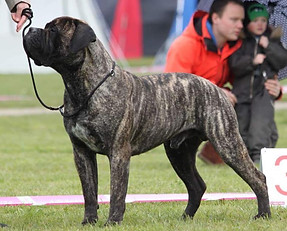
Photo courtesy of- Maja LH
(Fawn brindle)

Photo courtesy of- Steven Hearn
(Fawn brindle)

Photo courtesy of- Andrea Malatestinic
(Red/ Fawn brindle)

Photo courtesy of- Triona Rogers
(Red brindle)
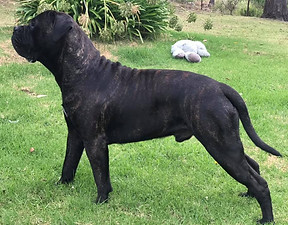
Photo courtesy of- Matt Wildner
(Red brindle)
In Bullmastiffs one parent must be a brindle to have brindle puppies in a litter, this is because the brindle gene is dominant. If a dog carries the gene it will express the brindle pattern, if the dog doesn't have brindle patterning it doesn't carry the gene. With that in mind it is therefore genetically impossible for 2 fawn or red parents to have a brindle puppy.
Below are some examples of the inheritance of the brindle pattern in various litter combinations.
kbr- Brindle
ky- Fawn or Red




Counter shading/ two toned
This term just refers to the lighter/ counter shading present on the inner legs/ thighs, face and chest, it can be seen in all 3 colours of the bullmastiff though tends to be more obvious in red examples. This pattern occurs in many breeds of dogs and even other species of animals such as deers, fox's and coyotes.

Photo courtesy of- RaBull Ilona


Photo courtesy of- Valerie Bosseaux
Photo courtesy of- Ielze Oph
White flash
White exists in the breed, it can range from from single white hair on the chest to a large flash. On rare occasions it can also pop up on the toes and sometimes as a thin line on the head. The white on the head and toes pretty much always grow out but the flash on the chest doesnt.

Photo courtesy of- Dereze Sandra

Photo courtesy of- Valerie Bosseaux
Unusual genetic anomalies within the breed
Dudley
The dudley is where the black part of the coat is diluted to brown anywhere from a chocolate colour through to a warm cinnamon, the eyes are typically light and sometimes green and the nose brown through to pink. The examples below are from matings of standard colour parents who carried the variation recessively through the B locus (Dilution).
B= None dilution
b= Dilution
This means that both parents carried one copy each of the dilution gene and so were Dd, the affected puppies who express this lighter colour inherited 2 copies of the dilution and are dd.
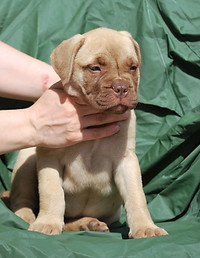
Photo courtesy of- Andrei Tenu

Photo courtesy of- Andrei Tenu
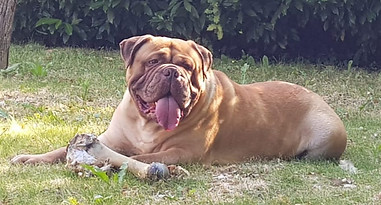
Photo courtesy of- Ielze Opheij

Photo courtesy of- Steph Neesam

Dilute
The dilute happens in the black areas of the coat turning them into a slate grey blue like silver, people sometimes confuse them with the dudley but they are in-fact not the same this is because the mutation has occurred on the D locus not the B. The puppy below is the result of mating 2 standard coloured dogs though they would have carried the dilute d gene recessively as Dd.


Standard colour litter siblings.
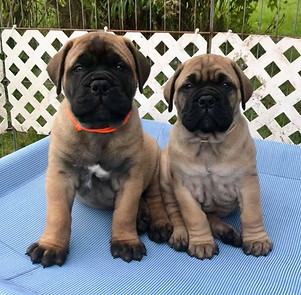
Photos courtesy of- Brandi Allan Jason Angle
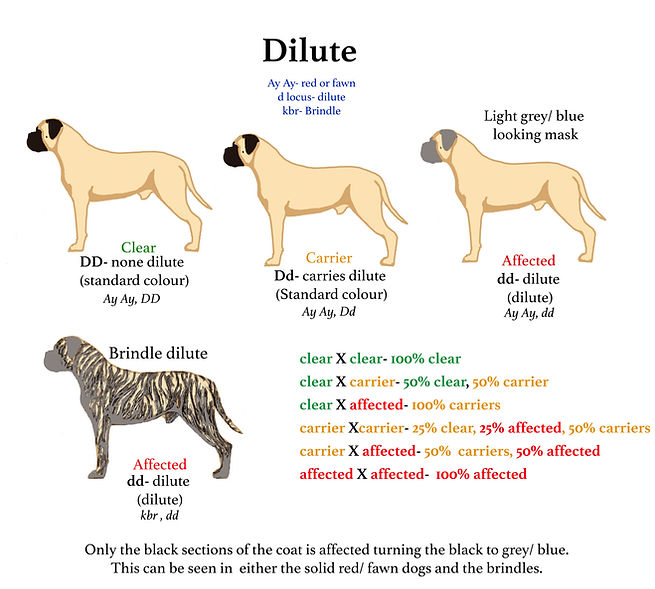
Somatic mutation
This mutation happens during the development of the embryo and presents itself as black patches of fur usually on a fawn or red base, this is not linked in any way to the brindle gene and is not inherited unlike the dilute or dudley.

Photo courtesy of- Tina Russell

Photo courtesy of- Giuseppe Mazzamuto
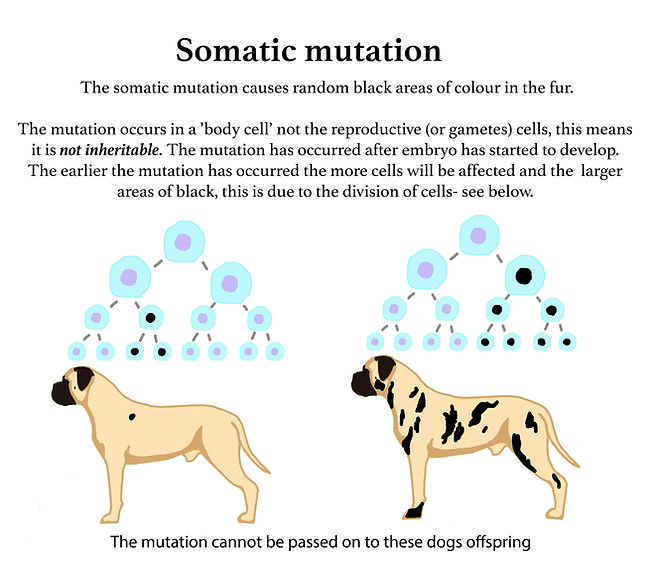
Long hair
The long haired bullmastiff is also affectionately called the 'wooly bully', these guys are pure bred bullmastiffs that have inherited the long hair gene. This gene has been identified now and can be tested at labs such as Labroklin, there is no associated health risk with the long hair as there are many long haired breeds already in existence.

Photo courtesy of- Deb Swain

Photo courtesy of- Deb Swain
The dog above was the result of breeding 2 standard coated parents that each carried one copy of the long hair gene, it is inherited like this-
Clear- A dog that is visually a short coat and carries 2 copies of the short coat gene
Carrier- A dog that is visually a short coat but carries 1 copy of the short and 1 copy of the long hair gene
Affected- A dog that is visually long haired and carries 2 copies of the long hair gene
Clear X Clear= 100% clear
Clear X Carrier= 50% clear, 50% carrier
Clear X Affected= 100% carriers
Carrier X Carrier= 25% clear, 25% carrier, 25% affected
Carrier X Affected= 50% carriers, 50% affected
Affected X Affected= 100% affected
Pied
As far as im aware this is the only photographic example of a pure bred pied bullmastiff. Pied did used to exist in mastiff types long ago and these would have been the foundation stock to the modern mastiffs and and thus the bullmastiff. My assumption is that it was probably more common way way far back when the breed was still in it infancy before the close registry system and it has over time been bred out. There are lots of paintings of old mastiff types that can be found depicting the pied coat.

I would like to say a big thank you to all the people that have allowed me to use their photographs. If you would like to learn more about coat colour genetics please go to 'this website'. There are also various groups on facebook dedicated to this that you can join.


